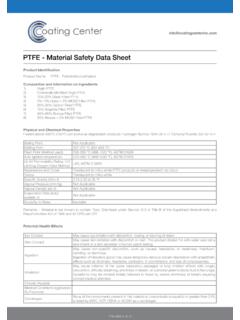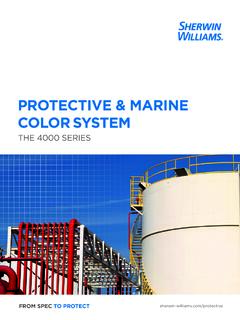Transcription of TOP DOWN AND BOTTOM UP APPROACHES - BDU OMS
1 Dr. G. Anand, M. R. Govt. Arts College, Mannargudi Page 1 TOP DOWN AND BOTTOM UP APPROACHES There are plenty of methods to synthesis nano materials. These methods are grouped into two categories namely Top-Down and BOTTOM -Up techniques. The techniques are classified based on the phase of the starting material. In the Top-down class of techniques, the starting material is in solid state, whereas in BOTTOM -Up techniques the starting material is either in gaseous state or in liquid state. Top-down approach refers to a subtractive process in which a bulk starting material is divided into smaller ones of nanosize. BOTTOM -up approach refers to an additive process that starts with precursor atoms (or) molecules which combine to form nanosized structure. In BOTTOM -up approach, nanostructures are built atom-by-atom or molecule-by-molecule. Depending on the requirement we have to select an appropriate method for prepration of nano materials.
2 Few methods are listed here Top-Down techniques BOTTOM -Up techniques 1) Mechanical grinding(Ball Milling) 2) Lithography 3) Etching 4) Erosion 1) Sol gel method 2) Chemical Vapour Deposition 3) Physical Vapour Deposition 4) Electrochemical deposition 5) Hydrothermal method 6) Atomic layer deposition TOP-DOWN TECHNIQUES Ball milling Ball milling also known as mechanical grinding is a simple and popular method. Here the materials are grinded into extremely fine powders. It is one of the most important processes used in industries to synthesize nanomaterials. This method has Dr. G. Anand, M. R. Govt. Arts College, Mannargudi Page 2 many advantages such as compact design, energy efficient, minimum maintenance, inexpensive and scalable. It works on the principle of impact. The size reduction is achieved through the impact caused when the balls drop from the top of the chamber in which the source material is placed.
3 Top-down and BOTTOM -up processes of nanosized material preparation. Etching The process of removing a surface layer from a metal or plastic surface through chemical erosion is known as chemical etching. This process involves one or more chemical reactions that consume the original reactants and produce new species. Dr. G. Anand, M. R. Govt. Arts College, Mannargudi Page 3 The chemical used for etching is called an etchant. In this process, the wafer to be etched can be immersed in a bath of etchant. Generally, etchants such as HCl, HN 3, 3S 4 and 3P 4 are used for etching semiconductor oxide thin films. Nanolithography Lithography is the transfer of a required pattern from a master slide/plate/mask to another medium. Nanolithography is one of widely used top down techniques for the preparation of nanostructured materials and patterns. Nanolithography techniques is based on depositing, masking, etching or writing the desired patterns with dimensions of the order of nanometers on a solid material surface.
4 Using this technique, a pattern or design can be transferred at once on the surface of a device by exposure with a radiation. Depending on the exposure radiation sources, like photons, X-rays, electrons and ions, the technique is classified as photolithography, X-ray lithography, electron-beam lithography and ion beam lithography, respectively. BOTTOM -UP TECHNIQUES Physical Vapour Deposition (PVD) Vacuum evaporation is one of the common physical vapor deposition methods. The source material to be deposited is evaporated in a high vacuum, by heating it using one of the following hearing sources: direct resistance, eddy current, electron beam, laser beam or an arc discharge. The vacuum allows vapor particles to travel directly to the substrate, where they condense to form a thin solid film. Chemical Vapour Deposition (CVD) The material precursor is heated and evaporated. The atoms and molecules are in gaseous phase.
5 The atoms or molecules react homogenously or heterogeneously and deposits on a solid surface. By CVD we can produce defect free and high purity nano materials. Dr. G. Anand, M. R. Govt. Arts College, Mannargudi Page 4 Sol-Gel Synthesis Sol-gel is one of the simple wet chemical techniques suitable for the preparation of nanoparticles (mostly oxides) and nanocrytalline thin films. It is a superior method to all available methods since this method is employed for large scale production at low method is based on inorganic polymerization reaction including hydrolysis, polycondensation, gelation, aging, drying and calcinations or sintering. Electro-chemical deposition Electro-chemical deposition is a process in which an electric current is used to reduce dissolved metal cations, so that they form a thin coherent metal coating on an electrode. It is also called electro-plating. Atomic layer deposition It is a subclass of chemical vapour deposition used to deposit ultra thin films.
6 In ALD, two chemicals (precursor) react with the surface of a material one at a time in a sequential, self - limiting manner. The reactant molecules react only with a finite number of reactive sites on the surface. CORE-SHELL NANOSTRUCTURES Core-shell nanostructures have unique structural features that consist of an inner core and an external shell of different chemical compositions. These structural features allow the possibility of combining distinctive properties of varied materials. Comparatively, core-shell nanostructures have exhibited improved physical and chemical properties relative to their single-component counterparts. The core shell structures are composite materials that contain an inner core coated with one or more layers (shells) of different materials. The materials of the core shell structures can exist in different combinations, such as core and shell materials that are organic or inorganic.
7 Dr. G. Anand, M. R. Govt. Arts College, Mannargudi Page 5 A large number of core-shell nanostructures have been successfully fabricated using APPROACHES ranging from laser ablation, high temperature evaporation to hydrothermal methods. One method to accomplish these objectives is through the coating of nanoparticles with one or more layers of other materials that have interesting properties. The surrounding layer is called the shell, and the original nanoparticle is named as the core. It has been discovered that the constructed layer, or shell, can change the function and properties of the original core. In other words, the core can exhibit new chemical or catalytic reactivity with shell formation. Multifunctional nanomaterials including (a) core shell, (b) hollow core shell, and (c) rattle core shell nanostructures This core shell concept presents two materials with two functions in one structure, as shown in Fig.
8 1a. By increasing the number of shells and/or the number of materials, the functions of the newly formed structure can consequently be increased, which then offers unlimited possibilities and extensive applications in many fields. The suitable design and geometry of the core shell structure allows the formation of other novel architectures, such as hollow core shell structures (as shown in Fig. 1b) through removal of the core and rattle core shell architecture (Fig. 1c) creation of one or more cavities between the outer shell and the inner solid core, producing a structure known as the rattle-type or yolk shell. In addition to the usual spherical morphology of core shell nanoparticles, there are many other possible shapes of core/shell nanoarchitectures, depending on the various Dr. G. Anand, M. R. Govt. Arts College, Mannargudi Page 6 core morphologies that are available, including nanorods, nanotubes, nanowires, nanorings and nanostars.
9 Designs to produce the different nanorattle architectures of (a) core shell, (b) multiple-core and (c) multiple-shell. Core shell Nanomaterials fabrication Several APPROACHES have been established to construct a protective layer or shell around different types of nanoparticle cores. In all of these methods, the cores are formed first, and then shell formation takes place. The core can be composed of various metals, metal oxides, quantum dots, and polymer materials. The core surfaces provide nucleation sites (seeds) for the shell atoms to nucleate and grow through sol gel or chemical precipitation APPROACHES . In other word, the core acts as a substrate for shell deposition. Different types of shell materials require different coating or shell formation strategies. Metal oxide shell. Metal oxide is a class of materials that possess a wide spectrum of properties. SiO2, Al2O3, ZrO2, TiO2 are few metal oxide shells. SiO2 is the most common metal oxide used for shell formation.
10 The well-established synthesis route used to prepare nanoparticle@SiO2 core shell nanostructures is the sol gel approach, which involves hydrolysis and condensation of the silica precursor (tetraethyl orthosilicate). The sol gel approach has been implemented for the coating of noble metal nanocores with silica shells, such as Au@SiO2,99 Dr. G. Anand, M. R. Govt. Arts College, Mannargudi Page 7 Applications The improved properties find broader range of applications including electronics, magnetism, optics, and catalysis 1. A magnetic core can be covered with a porous silica shell that can be loaded with drugs and provide biocompatibility, while the core can simultaneously be used for targeted delivery to a specific organ. 2. Quantum dots cores have been used for bio-imaging and diagnostic applications. 3. Iron, nickel, cobalt, manganese, chromium and gadolinium nanocores play important roles in magnetic resonance imaging as well as separation technology.






